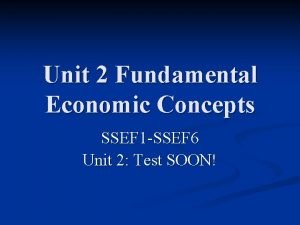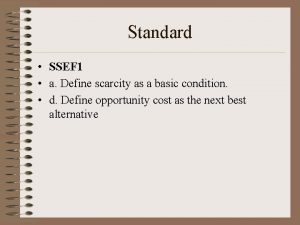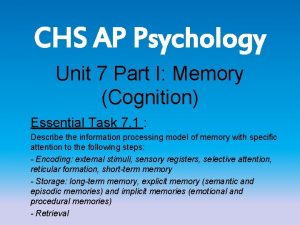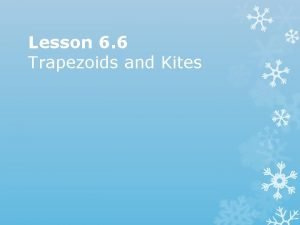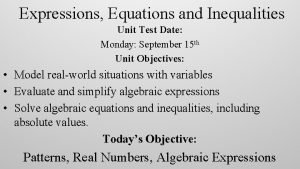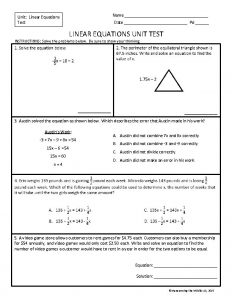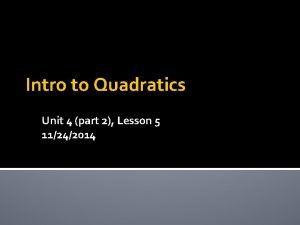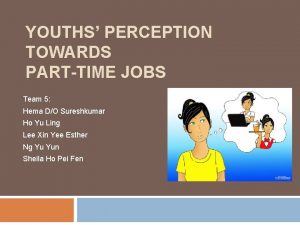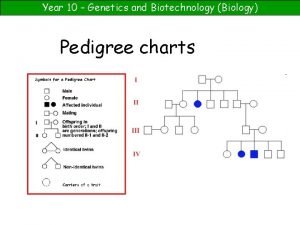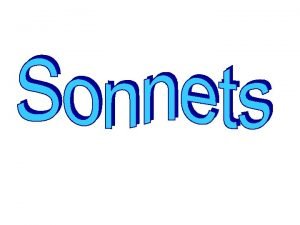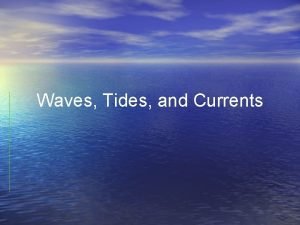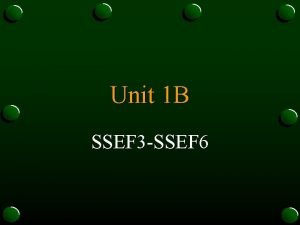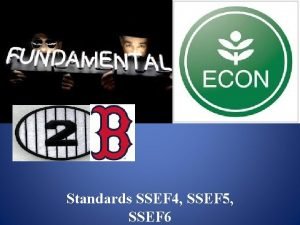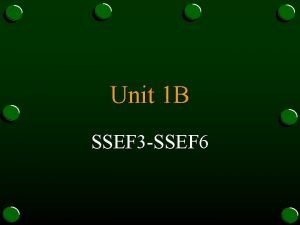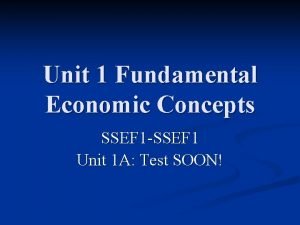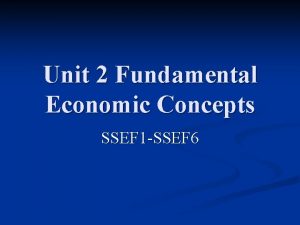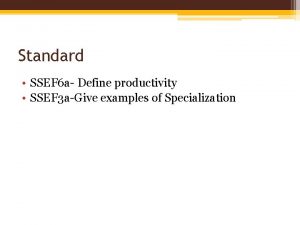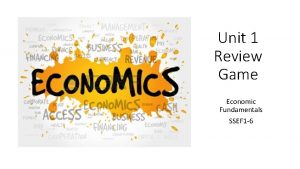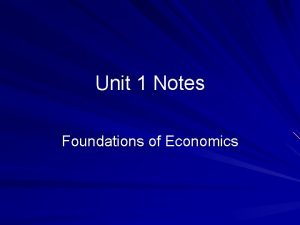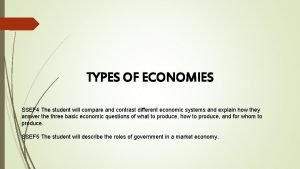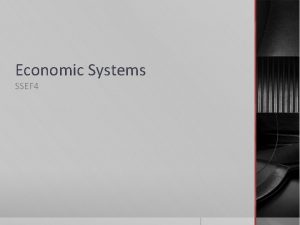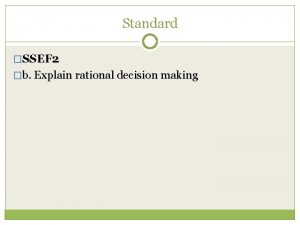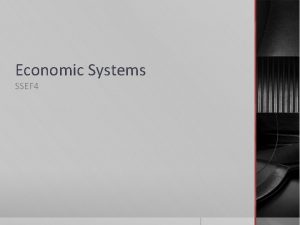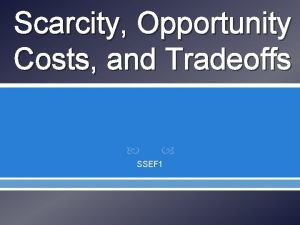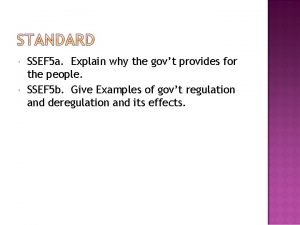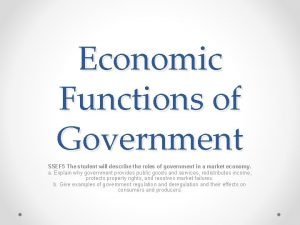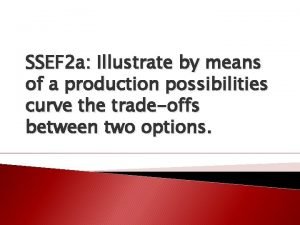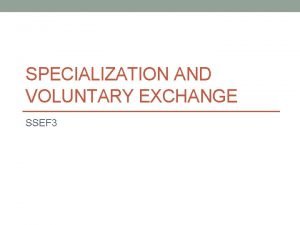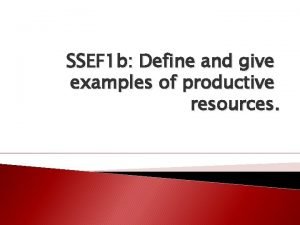Unit 1 Part II SSEF 4 SSEF 4















![] Private Ownership Profit Motive Consumer Sovereignty Competition Government Regulation Mixed Individuals, firms, and ] Private Ownership Profit Motive Consumer Sovereignty Competition Government Regulation Mixed Individuals, firms, and](https://slidetodoc.com/presentation_image/5e968cadb4a1a3342726b1d8728f471b/image-16.jpg)






















- Slides: 38

Unit 1: Part II SSEF 4

SSEF 4: • • Compare and contrast different economic systems and explain how they answer the three basic questions of, 1)What to produce? 2) How to Produce? 3) For Whom to Produce?

SSEF 4: A: • Compare Traditional, Market, and mixed economy systems with regard to Private ownership, profit motive, consumer sovereignty, and government regulation

Learning Target: • • Economic Systems I can compare traditional, command, market, and mixed economic systems in regard to private ownership, profit motive, consumer sovereignty, competition, and government regulation.

Traditional

Making just enough to survive • There social class & Factors of Production are passed down…generation to generation • Why does the wealthy benefit? •

Command Economies

Have a high degree of gov’t interaction, Gov’t owns Factor of Production, All the people • The MAIN reason that modern command economies have failed is that Gov’t decision-making led to shortages and inefficiency •

• http: //www. bbc. com/news/av/world-latin-america 31989893/how-long-does-it-take-to-buy-basicgoods-in-venezuela

Market Economy

• • • Producers and consumers determine what gets made Factors of Production are owned by the people Little to none gov’t regulation

Mixed Econ System Most nations have a mixed System in the world today. • Offers great freedom to economic actors while at the same time implementing enough government control to hopefully avoid economic catastrophes •

SSEF 4. A Chart: Learning Target: I can compare and contrast different economic systems. Private Ownership Traditional Rules of the culture…commune Profit Motive Work in the field of their ancestors……. . example……. . medicine man Consumer Sovereignty What has always been produced Competition Little to none…. operation the same way as ancestors Government Regulation Traditional leaders, chief, the elders will make decisions based on the culture and the past.

SSEF 4. A Chart: Learning Target: I can compare and contrast different economic systems. Private Ownership Command Very Little, Central Planner can confiscate at anytime , Everyone owns everything…even the Factors of Production! Profit Motive Extreme little, Central Planner takes all income Consumer Sovereignty Competition Little Choice for producers and consumers and limit what is available. Gov’t produces most goods and serves. No competition Government Regulation Complete and total

Market Private Ownership Profit Motive Consumer Sovereignty Competition Government Regulation Strong Property Rights, firms own the Factors of Production Incentives is the profit, Keep most if not all profits (Little taxes) Firms Produce only the goods and service consumers want. Extremely high because firms can open and close freely Minimal (protecting property and consumers from harm. )
![Private Ownership Profit Motive Consumer Sovereignty Competition Government Regulation Mixed Individuals firms and ] Private Ownership Profit Motive Consumer Sovereignty Competition Government Regulation Mixed Individuals, firms, and](https://slidetodoc.com/presentation_image/5e968cadb4a1a3342726b1d8728f471b/image-16.jpg)
] Private Ownership Profit Motive Consumer Sovereignty Competition Government Regulation Mixed Individuals, firms, and the Government can own land Entrepreneurs can start a business, expect to pay taxes and follow government regulations Business can produce what consumers want to buy, the government may produce certain goods and serves too. Competition exist and some monopolies are allowed to exist while others are broken up Government may require licenses and government paperwork to start a business: Labor, consumer safety and environmental laws.

EQ: • How do the six Broad Social goals answer the three basic economic questions?

SSEF 4. b • Analyze how each type of system answers the three economic questions and meets the broad social and economic goals of freedom, security, equity, growth, efficiency, price stability, full employment, and sustainability.

Learning Targets • • • 1. I can idendify the three basic economic Questions. 2. I can identify how each system answers the three economic questions. 3. I can identify how each system meets the broad social and economic goals.

(6) Broad Social Goals Vocab. • 1. Econ Efficiency~ Refers to how well scare productive resources are allocated to produce the goods and services people want…with the lowest costs possible.

2. Econ Equity~ • What is “Fair”? Econ actions and policies have to be evaluated in terms of what people think is right or wrong.

3. Econ Freedom~ • The freedom of consumers to decide how to spend or save their income, the freedom of workers to change jobs

4. Econ Growth • Refers to increasing the production of goods and services over time. Econ growth is measures by changes in the level of real gross domestic product (GDP). A target annual growth rate of 3 -4% in real GDP is generally considered to be reasonable and sustainable.

5. Econ Security~ • protecting consumers, producers, and resource owners from risks that exist in society. Each society must decide from which “uncertainties” individual can and should be protected, and whether individuals, employers, or the government should provide for this protection.

6. Econ Stability~ • Maintaining stable prices and full employment and keeping economic growth reasonably smooth and steady. Price stability means avoiding inflation or deflation. Full employment occurs when an economy’s scarce resources, especially labor, are fully utilized.

7. Full Employment • All those who are willing to and able to work have the opportunity to do so.

8. Sustainability • Refers to the goal of individual countries to maintain an upward trend of real GDP growth trend in the long-run

SSEF 4. B 3 -econ Traditional What to produce Generational, Central Planner based on the passed How to produce Passed from generation to generation Whom to produce Command Market Mixed Consumers taste Consumers and preferences governments need Central planner Method that selects the methods results in selling goods and services for the most profit $$$ Methods for a profit, but the government may tax firm profits or mandate production process However the past Whomever the Who ever is Willing and able methods were used central planner says willing and able to pay, the should get a good to pay government may restrict people from getting goods.

• Try to complete the chart based on what you know so far……………. . use the reading for guidance

SSEF 4. c Compare and Contrast strategies for allocating scarce resources, such as by price, majority rule, contests, force, sharing lottery, authority, first-comefirst served, and personal characteristics.

Price • Auction

Majority Rule

Contest

Forced • Factors of production of goods and serves are given or taken away under threats…. command economies. • Taxes…The Draft

Sharing

Lottery • Random selection, gives everyone who wants the good, service, or factor of production equal odds of obtaining it!

First Come, First SErved • Good, service or F of P if they get to it first or are one the people close enough to the front of the line to recieve …before none remain!

Personal Characteristics • Based on need or merit!
 Unit 1 review fundamental economic concepts answers
Unit 1 review fundamental economic concepts answers Ssef categories
Ssef categories 2016 ssef abstract form
2016 ssef abstract form Ssef price list
Ssef price list Unit 10, unit 10 review tests, unit 10 general test
Unit 10, unit 10 review tests, unit 10 general test Addition symbol
Addition symbol Unit ratio definition
Unit ratio definition Part part whole
Part part whole Technical descriptions
Technical descriptions Different parts of bar
Different parts of bar The phase of the moon you see depends on ______.
The phase of the moon you see depends on ______. 미니탭 gage r&r 해석
미니탭 gage r&r 해석 Unit 7 part 1 ap psychology
Unit 7 part 1 ap psychology Translational and rotational equilibrium
Translational and rotational equilibrium Geometry kite definition
Geometry kite definition 1.18 unit test solving inequalities - part 1
1.18 unit test solving inequalities - part 1 Equations and inequalities unit test part 1
Equations and inequalities unit test part 1 Computer parts external
Computer parts external Representativeness heuristic
Representativeness heuristic Linear equations unit test
Linear equations unit test Unit test review algebra 2
Unit test review algebra 2 Unit 6 part 2
Unit 6 part 2 Unit 7 progress check: mcq part c
Unit 7 progress check: mcq part c Unit 4 part 2
Unit 4 part 2 Unit 6 part 1
Unit 6 part 1 Metode pembiayaan semi langsung
Metode pembiayaan semi langsung Hyp opp adj
Hyp opp adj English unit conversion
English unit conversion Unit test algebra 2
Unit test algebra 2 Unit cost rekam medis
Unit cost rekam medis Unit process and unit operation
Unit process and unit operation Unit operation and unit process
Unit operation and unit process Setiap unit akuntansi dianggap sebagai unit yang mandiri
Setiap unit akuntansi dianggap sebagai unit yang mandiri Proto 5hema
Proto 5hema Part 10 pedigree charts
Part 10 pedigree charts Whats a friendly letter
Whats a friendly letter Sestet sonnet
Sestet sonnet The highest part of a wave
The highest part of a wave The highest part of a wave
The highest part of a wave
